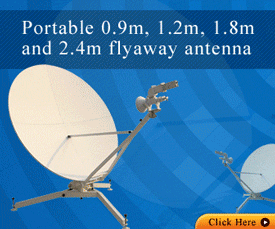Home »
Vsat Studies »
VSAT System Chara...
VSAT System Characteristics
VSAT, short for Very Small Aperture Terminal, can be translated into very small aperture terminal. Here aperture refers to antenna aperture of satellite earth station. This sort of technology, born in the 70s, enters a high developing stage in the 80s. There are about 200,000 VSAT stations which have been put into operation at the moment.
The development of VSAT system is realized under the influence of the two factors of demand pulling and technology promoting. From the aspects of technology, VSAT system has the following characteristics:
1. It possesses the ability of digital treatment and transmission for multiple signals including voice, data and television conference. When transmitting voice, data and television conference, data compression technology has been widely adopted.
2. Flexible multi-access mode. The transmission line from primary station to remote small station is called outbound or outroute while the transmission link from small station to primary station is called inbound or inroute. The outbound information flow is discontinuous and the inbound information flow is intermittent, both of business volumes are asymmetric. Therefore, VSAT system adopts different multi-access continuation mode respectively in two transmission directions to realize asymmetric bidirectional transmission, which is the main difference between VSAT and other satellite communication system.
3. Network management system is more and more perfect. Because the information of small station is burst information, VSAT system must configure high intelligent network management system to monitor, control and manage operation status, channel allocation, business volume statistics of the overall network, which is one of the differences between VSAT and other satellite communication system.
4. Abundant network topological structure. Network topological structure of VSAT has three kinds which are star-shaped, meshed and composite. Star-shaped structure mainly applied in data communication must have primary station. Meshed structure mainly applied in voice communication doesn’t have primary station. And composite structure with more complex network management and channel control is available for large website comprehensively transferring multiple sets of information. The selection of network topological structure is mainly based on business demand.
5. VSAT device becomes gradually miniaturization and integration and the device price continues to drop, which makes VSAT system possess characteristics of easy installation, cheap price and convenient maintenance, etc.. The initial investment is quite large but the maintenance cost is cheaper.
6. Compared with other communication ways, VAST system possess the characteristic that communication link cost is not relevant to the distance, thus it is particularly applied to remote areas.
7. VSAT system expansion is easier. Use scope and transmission ability of VSAT can be expanded as long as the number of small station is increased and the bandwidth of uplink carrier and downlink carrier is adjusted according to the demand. The system’s expansion ability has much to do with equipment’s model selection; therefore, it should have certain predictability for development prospect of the system when designing the system.
The development of VSAT system is realized under the influence of the two factors of demand pulling and technology promoting. From the aspects of technology, VSAT system has the following characteristics:
1. It possesses the ability of digital treatment and transmission for multiple signals including voice, data and television conference. When transmitting voice, data and television conference, data compression technology has been widely adopted.
2. Flexible multi-access mode. The transmission line from primary station to remote small station is called outbound or outroute while the transmission link from small station to primary station is called inbound or inroute. The outbound information flow is discontinuous and the inbound information flow is intermittent, both of business volumes are asymmetric. Therefore, VSAT system adopts different multi-access continuation mode respectively in two transmission directions to realize asymmetric bidirectional transmission, which is the main difference between VSAT and other satellite communication system.
3. Network management system is more and more perfect. Because the information of small station is burst information, VSAT system must configure high intelligent network management system to monitor, control and manage operation status, channel allocation, business volume statistics of the overall network, which is one of the differences between VSAT and other satellite communication system.
4. Abundant network topological structure. Network topological structure of VSAT has three kinds which are star-shaped, meshed and composite. Star-shaped structure mainly applied in data communication must have primary station. Meshed structure mainly applied in voice communication doesn’t have primary station. And composite structure with more complex network management and channel control is available for large website comprehensively transferring multiple sets of information. The selection of network topological structure is mainly based on business demand.
5. VSAT device becomes gradually miniaturization and integration and the device price continues to drop, which makes VSAT system possess characteristics of easy installation, cheap price and convenient maintenance, etc.. The initial investment is quite large but the maintenance cost is cheaper.
6. Compared with other communication ways, VAST system possess the characteristic that communication link cost is not relevant to the distance, thus it is particularly applied to remote areas.
7. VSAT system expansion is easier. Use scope and transmission ability of VSAT can be expanded as long as the number of small station is increased and the bandwidth of uplink carrier and downlink carrier is adjusted according to the demand. The system’s expansion ability has much to do with equipment’s model selection; therefore, it should have certain predictability for development prospect of the system when designing the system.


